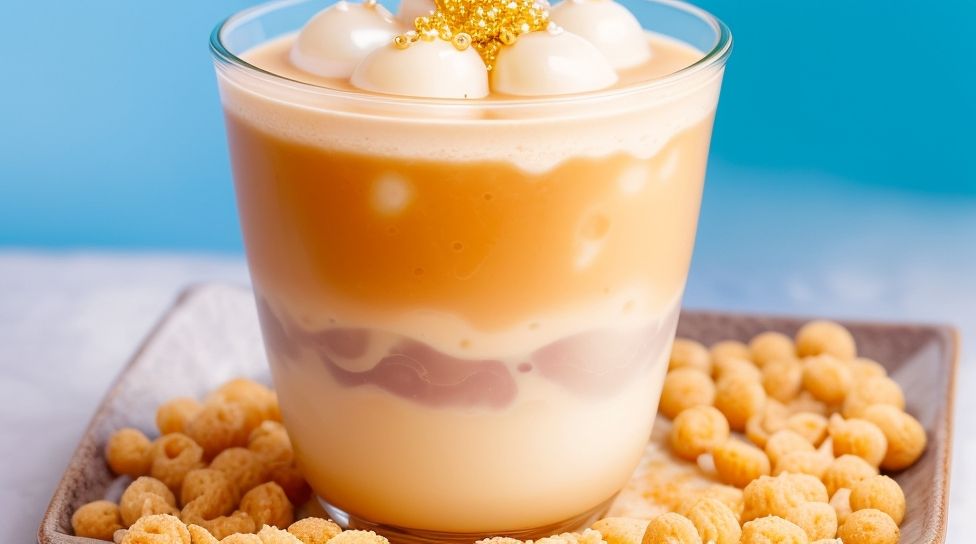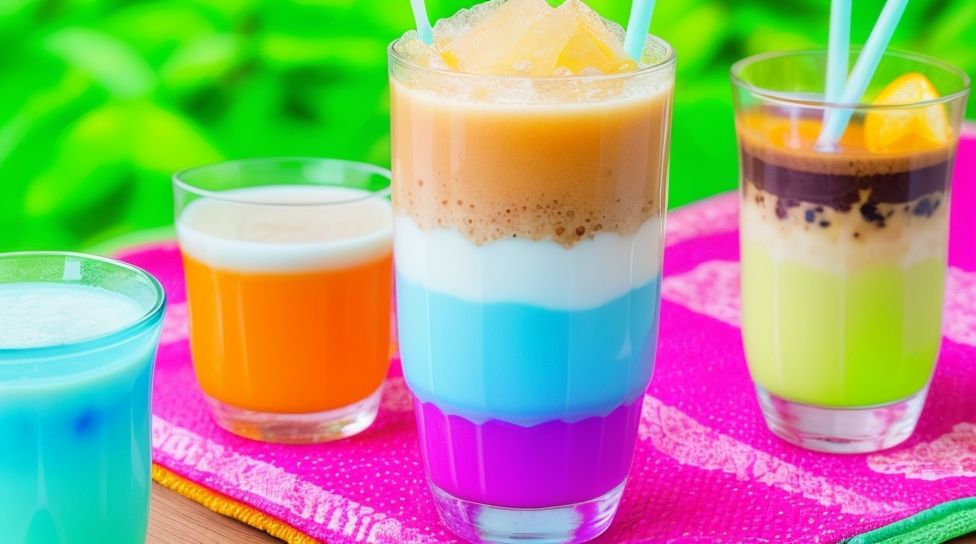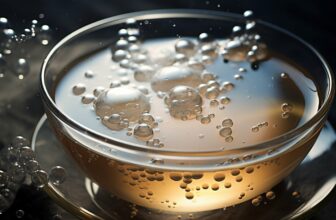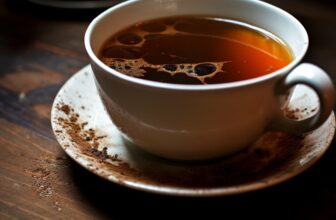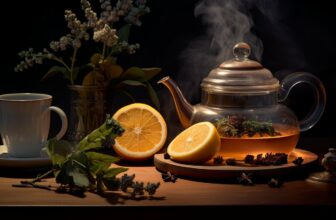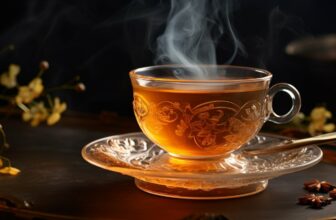
Milk tea, also known as boba tea or pearl milk tea, is a popular beverage that originated in Taiwan and has gained widespread popularity around the world. It is a combination of tea, milk, and sweeteners or flavors, creating a unique and delicious taste. Milk tea typically uses a variety of teas as its base, including black tea, green tea, oolong tea, or even herbal teas like chamomile or jasmine. The choice of tea can greatly influence the flavor profile of the milk tea.
In addition to tea, milk is an essential component of milk tea. While traditional milk teas often use dairy milk, non-dairy alternatives like almond milk, soy milk, or coconut milk can also be used, catering to different dietary preferences.
When it comes to the taste of milk tea, it does have a distinct tea flavor but is often balanced with the creamy and sweet elements of the milk and added sweeteners. The flavor profiles can vary depending on the type of tea used, the proportion of milk to tea, and the additional flavorings or sweeteners added.
Milk tea usually has a sweet taste due to the inclusion of sugar, honey, or flavored syrups. However, the sweetness level can be adjusted according to personal preference.
As for the texture, milk tea often has a creamy and smooth mouthfeel due to the presence of milk. This adds richness and depth to the overall drinking experience.
There are various variations of milk tea available, each with its own unique twist. Some popular variations include bubble tea, which includes tapioca pearls or other toppings, and flavored milk teas like matcha milk tea or taro milk tea.
It’s important to note that milk tea is different from bubble tea and chai tea. Bubble tea specifically refers to milk tea with the addition of tapioca pearls or other toppings, while chai tea is a spiced tea beverage originating from India that is typically made with milk and various spices.
Key takeaway:
- Milk tea is a popular beverage: Milk tea is a combination of tea and milk, resulting in a unique and refreshing drink.
- Milk tea has various flavor profiles: Depending on the ingredients and preparation method, milk tea can have flavors like sweet, creamy, and aromatic, making it a versatile drink for different preferences.
- Milk tea is enjoyed worldwide: Milk tea is a beloved beverage in many countries and cultures, with variations and popular add-ons that cater to different tastes and preferences.
What is Milk Tea?
Photo Credits: Www.Teamastershub.Com by Samuel Clark
Milk tea is a popular beverage that combines tea and milk, creating a unique and creamy flavor profile. It is enjoyed in various cultures and comes in different variations.
Milk tea typically consists of steeped or brewed tea (such as black tea, green tea, or oolong tea) that is then mixed with milk (often cow’s milk, but alternatives like almond milk or soy milk can also be used) to create a smooth and creamy texture.
The taste of milk tea can vary depending on the type of tea used, the ratio of tea to milk, and any additional ingredients or sweeteners added. Milk tea generally has a rich, mellow, and slightly sweet flavor due to the combination of the tea’s natural bitterness and the sweetness of the milk.
Some common variations of milk tea include:
- Classic Milk Tea: This is the basic version of milk tea, typically made with black tea and sweetened with sugar or other sweeteners.
- Chai: Chai is a spiced milk tea originating from India, often made with black tea, milk, and a blend of spices like cardamom, cinnamon, ginger, and cloves.
- Bubble Tea: Also known as boba tea, bubble tea is a Taiwanese creation that incorporates milk tea with chewy tapioca pearls or other toppings like fruit jelly or pudding.
- Hong Kong Milk Tea: This variation is popular in Hong Kong and is made by filtering the tea multiple times through a cloth bag, resulting in a strong and robust flavor.
Milk tea is loved for its comforting and soothing qualities. It offers a pleasant combination of the natural flavors of tea and the creamy richness of milk, providing a delightful beverage for tea enthusiasts and those looking for a comforting and flavorful drink.
What are the Ingredients of Milk Tea?
Photo Credits: Www.Teamastershub.Com by Eric Anderson
The ingredients of milk tea typically include:
- Tea: The base of milk tea is usually black tea, green tea, oolong tea, or a blend of these teas. The type of tea used can affect the overall flavor profile.
- Milk: Milk is an essential component of milk tea. It can be regular dairy milk or non-dairy alternatives like almond milk, soy milk, or coconut milk. The choice of milk can impact the taste and texture of the drink.
- Sweetener: Sugar or other sweeteners like honey or condensed milk are often added to milk tea to enhance its taste and provide a balanced sweetness.
- Flavorings: Various flavorings can be added to milk tea to create different variations. Common flavorings include vanilla, chocolate, caramel, fruit syrups, or floral essences like rose or lavender.
- Toppings: Milk tea can be served with toppings for added texture and flavor. Popular toppings include tapioca pearls (boba), jelly, pudding, grass jelly, or popping boba.
The combination of these ingredients creates a unique and distinct taste for milk tea. The tea flavor, sweetness level, creaminess from the milk, and any additional flavorings or toppings contribute to the overall taste experience.
What type of Tea is used in Milk Tea?
The type of tea used in milk tea can vary depending on personal preference and regional traditions. The most commonly used tea in milk tea is black tea. Black tea provides a bold and robust flavor that pairs well with the richness of milk and other ingredients.
Black tea, which is fully oxidized, is known for its distinct flavor and dark color. It is often chosen for milk tea because its strong taste can stand up to the addition of milk and sweeteners.
Black teas such as Assam, Ceylon, and Earl Grey are popular choices for milk tea. Assam tea, originating from India, has a malty and slightly sweet flavor that adds depth to milk tea. Ceylon tea, from Sri Lanka, has a bright and citrusy taste that balances well with milk. Earl Grey, a flavored black tea infused with bergamot oil, adds a unique floral and citrusy note to milk tea.
Other types of tea, such as green tea or oolong tea, can also be used in milk tea, offering different flavor profiles and nuances. However, black tea remains the most common and traditional choice for that classic milk tea taste.
Fun Fact: Black tea is the most consumed type of tea worldwide and is known for its numerous health benefits, including potential improvements in heart health and digestion.
What kind of Milk is used in Milk Tea?
Milk tea can be made with various types of milk, depending on personal preference and dietary restrictions. Some common types of milk used in milk tea include cow’s milk, almond milk, soy milk, and coconut milk. Each type of milk imparts a different flavor and texture to the tea.
1. Cow’s milk: This is the most commonly used milk in milk tea. It adds a creamy and rich taste to the tea. Cow’s milk is known for its smooth texture and mild flavor.
2. Almond milk: For those wondering, “What kind of Milk is used in Milk Tea?” almond milk is a popular alternative. It has a slightly nutty taste and gives the milk tea a light and slightly sweet flavor.
3. Soy milk: For those looking for a dairy-free option in their milk tea, soy milk is a perfect choice. It has a creamy texture and a slightly earthy, bean-like taste. Soy milk blends well with the tea, creating a smooth and balanced beverage.
4. Coconut milk: For milk teas with a tropical twist, coconut milk is commonly used. It adds a rich and creamy texture and imparts a subtle hint of coconut flavor to the tea.
When choosing the best type of milk for your milk tea, consider your taste preferences and dietary needs. Experiment with different types of milk to find the one that enhances the flavor of your milk tea the most.
Does Milk Tea Have a Sweet Taste?
When it comes to the taste of milk tea, does milk tea have a sweet taste? it can have a sweet flavor profile that appeals to those with a sweet tooth. Here are a few things to consider:
- Milk tea is made by combining tea with milk and sweeteners such as sugar or condensed milk.
- The sweetness of milk tea can vary depending on the amount of sweetener added. Some people prefer a more subtle sweetness, while others enjoy a stronger and sweeter taste.
- The type of tea used in milk tea can also affect its sweetness. Popular tea varieties used in milk tea include black tea, green tea, and oolong tea.
- Additional flavors like fruit syrups or flavored powders can be added to enhance the sweetness of milk tea.
Pro-tip: If you prefer a less sweet taste, you can ask for less sweetener or try variations like unsweetened milk tea or adding natural sweeteners like honey or stevia. Experimenting with different tea and milk combinations can help you find the perfect balance of sweetness in your milk tea.
Does Milk Tea Have a Creamy Texture? Only if someone had the courage to milk a cloud and blend it with tea.
Does Milk Tea Have a Creamy Texture?
- Yes, milk tea generally has a creamy texture due to the addition of milk or creamer.
- The creamy texture of milk tea is achieved by combining the brewed tea with milk or creamer.
- The amount of milk or creamer added varies depending on personal preference, with options ranging from a light creamy texture to a richer, creamier consistency.
- The creaminess of milk tea can be further enhanced by frothing or steaming the milk before adding it to the tea.
- Milk tea with a creamy texture provides a smooth and velvety mouthfeel, complementing the flavors of the tea.
- For those who prefer a thicker and more indulgent texture, condensed milk can be used as a sweetener and creamer in milk tea.
- Non-dairy alternatives such as almond milk, coconut milk, or soy milk can also be used to create a creamy texture in milk tea for individuals with lactose intolerance or dietary restrictions.
- The creamy texture of milk tea adds a comforting and satisfying element to the overall drinking experience.
- It is important to note that the creamy texture of milk tea may vary depending on the type of tea used, the ratio of tea to milk, and the specific recipe or technique employed in its preparation.
- Experimenting with different types of tea, milk, and ratios can help you find the perfect balance for achieving the desired creamy texture in your milk tea.
What’s the difference between bubble tea and milk tea? One has chewy balls, the other has ballsy flavor.
What is the Difference between Bubble Tea and Milk Tea?
The difference between bubble tea and milk tea can be summarized in the following table:
| Bubble Tea | Milk Tea |
| Bubble tea is a type of tea beverage that originated in Taiwan. | Milk tea is a general term used to refer to any tea beverage that includes milk as an ingredient. |
| It typically contains tea, milk, sweeteners, and chewy tapioca pearls (also known as “boba”). | Milk tea can be made with various types of tea and can include additional ingredients such as sweeteners, flavorings, or toppings, but it does not necessarily contain tapioca pearls. |
| The distinctive feature of bubble tea is the addition of tapioca pearls, which provide a unique texture and chewing experience. | Milk tea can have different textures depending on the ingredients used, but it does not typically have the chewy tapioca pearls found in bubble tea. |
| Bubble tea is often served with a wide straw to allow the tapioca pearls to be consumed along with the drink. | Milk tea can be served with a regular straw or without any specific utensils, depending on the specific preparation and presentation. |
| Bubble tea gained popularity for its unique combination of flavors, textures, and the fun experience of drinking through a straw and chewing the pearls. | Milk tea, on the other hand, is popular for its creamy and comforting taste, often served hot or cold. |
When considering the difference between bubble tea and milk tea, it is important to note that bubble tea is a specific type of tea beverage that includes tapioca pearls, while milk tea is a broader category that refers to any tea beverage that incorporates milk.
Chai tea and milk tea may sound similar, but one will transport you to India while the other will give you a taste of East Asia, proving that tea can serve as a delicious passport.
What is the Difference between Chai Tea and Milk Tea?
The difference between Chai tea and Milk tea can be understood through the following table:
| Aspect | Chai Tea | Milk Tea |
| Ingredients | Black tea leaves, milk, sugar, spices (such as cinnamon, ginger, cardamom, and cloves) | Black tea leaves, milk, sugar or sweetener |
| Flavor | Strong, bold, and spicy due to the addition of various spices | More subtle, creamy, and milder compared to Chai tea |
| Traditional Origin | Originated in India and is commonly consumed in South Asia | Consumed worldwide, with variations in different countries |
| Serving Style | Can be served hot or cold | Can be served hot or cold |
| Common Additions | Chai tea may often be served with additional spices like cardamom pods or cinnamon sticks | Milk tea may be customized with additional flavors like fruit syrups, boba pearls, or jelly |
As seen from the table, the difference between Chai Tea and Milk Tea lies in their ingredients, flavor, traditional origin, serving style, and common additions. Chai tea consists of black tea leaves, milk, sugar, and various spices like cinnamon, ginger, cardamom, and cloves, giving it a strong and bold taste. In contrast, milk tea is made with black tea leaves, milk, and sugar or sweetener, resulting in a milder and creamier flavor compared to Chai tea. Chai tea originated in India and is commonly consumed in South Asia, whereas milk tea is enjoyed worldwide with variations in different countries. Both types of tea can be served hot or cold. Additionally, Chai tea is often served with extra spices like cardamom pods or cinnamon sticks, whereas milk tea can be customized with flavors such as fruit syrups, boba pearls, or jelly.
Does Milk Tea Taste Like Tea? It’s like tea dipped in elegance and swirled with creamy charisma.
Does Milk Tea Taste Like Tea?
Photo Credits: Www.Teamastershub.Com by Philip Jackson
Milk tea does have a noticeable tea flavor, but its taste is distinct from regular tea due to the addition of milk and sometimes sweeteners. Here are some key points to understand about the taste of milk tea:
Tea Flavor: Milk tea generally retains the flavor of the tea it is made with. Depending on the type of tea used, such as black, green, or oolong, the tea flavor can range from earthy and bold to floral and delicate.
Milky and Creamy: The addition of milk gives milk tea a creamy and smooth texture. The milk adds richness and often softens the bitterness or astringency that can be present in tea.
Sweetness: Many milk tea variations include sweeteners like sugar, honey, or flavored syrups. The level of sweetness can vary depending on personal preference or the specific recipe followed.
Subtle Notes: Milk tea may have subtle undertones or notes that complement the tea flavor. For instance, some recipes incorporate spices like cinnamon or cardamom, while others may add a hint of vanilla or floral extracts.
Customizable: One of the appealing aspects of milk tea is its versatility. It can be customized by adjusting the tea-to-milk ratio, sweetness level, and additional flavors to suit individual tastes.
While milk tea does contain the essence of tea, its taste is distinct due to the addition of milk, sweetness, and other flavorings. The combination creates a unique and enjoyable beverage that is loved by many.
What are the Flavor Profiles of Milk Tea?
Photo Credits: Www.Teamastershub.Com by Henry Lewis
Milk tea offers a unique and delicious flavor profile that combines the distinct characteristics of tea and milk. Here are some key flavor profiles you can expect when tasting milk tea:
- Tea Flavor: Depending on the type of tea used, milk tea can have a variety of tea flavors. It can range from the robust and earthy notes of black tea to the delicate and floral notes of green tea or the aromatic and complex flavors of oolong tea.
- Sweetness: Milk tea is often sweetened with sugar or other sweeteners. The level of sweetness can vary depending on personal preference or the recipe used. It adds a pleasant sweetness that balances the bitterness of the tea.
- Creaminess: The addition of milk or cream gives milk tea a creamy and smooth texture. This creaminess adds richness to the drink and enhances the overall mouthfeel.
- Subtle Nuttiness: Some types of milk tea, such as Thai milk tea, may have a subtle nutty flavor. This can come from ingredients like crushed almonds or other nuts used in the preparation.
- Aroma: Milk tea has a delightful aroma that combines the fragrant notes of the tea with the creamy scent of milk. The aroma can vary depending on the type of tea used and any additional ingredients or flavorings.
- Additional Flavors: Milk tea can be enhanced with various additional flavors such as vanilla, caramel, chocolate, or fruit syrups. These flavors can add complexity and depth to the overall taste of the milk tea.
The specific flavor profile of milk tea can vary based on the recipe, brewing method, tea type, and other factors. The combination of tea, milk, sweetness, and creaminess creates a harmonious and enjoyable taste experience that is loved by many tea enthusiasts around the world.
What are the Variations of Milk Tea?
Photo Credits: Www.Teamastershub.Com by Stephen Ramirez
Milk tea comes in various delicious variations. Here are some of the most popular:
- Classic Milk Tea: This is the traditional milk tea made with black tea leaves and milk. It has a rich, creamy flavor with a hint of sweetness.
- Thai Milk Tea: Thai milk tea is known for its vibrant orange color and its unique blend of black tea, condensed milk, and spices like star anise and cardamom. It has a sweet and spiced flavor profile.
- Hong Kong Milk Tea: Hong Kong-style milk tea is made by brewing a blend of black tea leaves and then straining it through a cloth bag. It is often served with evaporated milk, giving it a smooth and creamy taste.
- Boba Milk Tea: Boba, or bubble tea, is a popular variation of milk tea that originated in Taiwan. It typically includes black tea, milk, and chewy tapioca pearls. It can be served hot or cold.
- Matcha Milk Tea: Matcha milk tea combines the earthy and grassy flavors of matcha green tea powder with the creamy sweetness of milk. It has a unique and distinct taste.
- Oolong Milk Tea: Oolong milk tea is made with oolong tea leaves, which have a slightly floral and toasty flavor. When paired with milk, it creates a smooth and mellow taste.
- Earl Grey Milk Tea: Earl Grey milk tea combines the citrusy flavor of Earl Grey tea with the creaminess of milk. It has a fragrant and refreshing taste.
- Jasmine Milk Tea: Jasmine milk tea features the delicate aroma and floral notes of jasmine tea, combined with the creamy texture of milk. It offers a soothing and aromatic experience.
- Taro Milk Tea: Taro milk tea is made with taro root, which gives it a unique and slightly sweet nutty flavor. It is often blended with milk and can be enjoyed hot or cold.
Each variation of milk tea has its own distinct taste and appeal, offering a wide range of options to suit different preferences and cravings.
What are the Healthier Ingredients in Milk Tea?
Photo Credits: Www.Teamastershub.Com by Charles Nguyen
When it comes to healthier ingredients in milk tea, consider the following options:
- Tea: Choose milk tea made with high-quality tea leaves, such as green tea, black tea, or herbal teas. These teas are rich in antioxidants and offer various health benefits.
- Low-fat or Plant-based Milk: Opt for milk tea made with low-fat milk or plant-based milk alternatives like almond milk, soy milk, or oat milk. These options are lower in saturated fat and cholesterol compared to full-fat dairy milk.
- Minimal Sweeteners: Look for milk tea with minimal sweeteners or options to customize the sweetness level. Too much added sugar can contribute to health issues, so choosing unsweetened or lightly sweetened versions can be a healthier choice.
- Natural Flavorings: Consider milk tea flavored with natural ingredients like fruit extracts, vanilla, or spices. Avoid artificial flavorings and additives whenever possible.
- Fruit or Herbal Infusions: Explore milk tea variations that incorporate fruit or herbal infusions instead of artificial syrups. These infusions can add flavor and health benefits without the need for excessive sugar or artificial ingredients.
- Reduced Portion Sizes: Opt for smaller serving sizes of milk tea to control calorie intake. This can help prevent overconsumption of calories and sugar.
- Personalization: Many milk tea shops offer the option to customize your drink. Take advantage of this by choosing healthier ingredients and controlling the amount of sugar or sweeteners added.
- Homemade Options: Consider making milk tea at home using high-quality ingredients and controlling the sweetness and portion sizes. This allows you to have full control over the ingredients and make healthier choices.
By selecting milk tea with these healthier ingredients and being mindful of portion sizes and sweeteners, you can enjoy this beverage while making choices that align with your health goals.
How is Milk Tea Prepared?
Photo Credits: Www.Teamastershub.Com by Douglas Campbell
Milk tea is prepared using the following steps:
- Tea Brewing: Start by brewing a strong cup of tea using your preferred type of tea leaves, such as black tea or green tea. The tea leaves are steeped in hot water for a specific duration, depending on the desired strength.
- Addition of Milk: Once the tea is brewed, warm milk is added to it. The amount of milk can vary based on personal preference, ranging from a small splash to a larger quantity for a creamier taste.
- Sweetener: To enhance the flavor, sweetener is added to the milk tea. This can be in the form of sugar, honey, or other sweetening agents. The amount of sweetener can be adjusted according to taste.
- Mixing: Stir the mixture well to ensure that the milk and sweetener are thoroughly combined with the tea. This helps create a uniform and balanced flavor.
- Optional Additions: Depending on personal preferences, additional ingredients can be added to the milk tea. This could include tapioca pearls (commonly known as boba), flavored syrups, or spices like cinnamon or cardamom.
- Serving: The prepared milk tea can be served hot or cold, depending on individual preference. It is typically poured into a cup or glass and can be garnished with toppings like whipped cream or a sprinkle of cocoa powder.
The taste of milk tea can vary depending on factors such as the type of tea used, the amount of milk, and the choice of sweetener. Generally, milk tea has a rich and creamy flavor with a hint of sweetness, complemented by the natural flavors and aromas of the tea leaves used.
How to Make Milk Tea at Home?
Photo Credits: Www.Teamastershub.Com by Roger Johnson
To make milk tea at home, follow these simple steps:
- Choose your tea: Select the type of tea you prefer, such as black tea, green tea, or oolong tea. Each tea will impart a unique flavor to your milk tea.
- Brew the tea: Boil water and steep the tea leaves or tea bags according to the recommended brewing time. Adjust the brewing time based on your preference for a stronger or milder tea flavor.
- Add sweetener (optional): If you prefer sweetened milk tea, add your desired sweetener, such as sugar, honey, or syrup, to the brewed tea. Stir well to dissolve the sweetener.
- Heat the milk: In a separate pot, heat the milk of your choice. You can use dairy milk, almond milk, soy milk, or any other milk substitute. Heat the milk until it is hot but not boiling.
- Mix the tea and milk: Pour the hot milk into the brewed tea. Adjust the ratio of tea to milk based on your preference for a stronger tea flavor or a creamier taste. Stir well to combine the tea and milk.
- Optional additions: You can add additional flavorings to your milk tea, such as vanilla extract, cinnamon, or cardamom, to enhance the taste. Experiment with different flavors to find your favorite combination.
- Serve: Pour the prepared milk tea into a cup or glass. You can add ice cubes for a cold milk tea or enjoy it hot. Garnish with a sprinkle of cocoa powder, cinnamon, or boba pearls, if desired.
By following these steps, you can easily make milk tea at home and customize it to suit your taste preferences. Enjoy the delightful and comforting flavors of homemade milk tea!
What are the Popular Milk Tea Add-Ons?
Photo Credits: Www.Teamastershub.Com by Nathan Gonzalez
Milk tea is a versatile beverage that can be enhanced with various add-ons to create unique flavors and textures. Here are some popular milk tea add-ons:
- Tapioca Pearls: Also known as boba, tapioca pearls are chewy, translucent balls made from cassava starch. They add a delightful texture to milk tea and are often found at the bottom of the drink.
- Pudding: Milk tea can be topped with creamy pudding, typically made from ingredients like milk, eggs, and sugar. It adds a smooth and velvety texture to the beverage.
- Jelly: Jelly is a popular milk tea add-on that comes in various flavors, such as lychee, mango, or grass jelly. It adds a refreshing and slightly chewy element to the drink.
- Aloe Vera: Aloe vera gel can be added to milk tea for a unique and soothing texture. It provides a light and refreshing taste.
- Red Bean: Sweetened red beans, often used in Asian desserts, can be added to milk tea to create a creamy and slightly nutty flavor.
- Coconut Jelly: Coconut jelly, made from coconut water or milk, is a popular add-on that adds a tropical twist to milk tea.
- Grass Jelly: Grass jelly is a herbal jelly made from the leaves of the Mesona chinensis plant. It has a slightly bitter taste that complements the sweetness of milk tea.
- Cream Cheese Foam: Cream cheese foam is a creamy and slightly salty topping that can be added to milk tea. It creates a rich and velvety texture.
- Matcha: Matcha powder can be blended into milk tea to add a vibrant green color and a distinct earthy flavor.
- Flavored Syrups: Various flavored syrups, such as caramel, vanilla, or hazelnut, can be added to milk tea to enhance the taste and add sweetness.
These popular milk tea add-ons offer a wide range of flavors, textures, and combinations to suit different preferences and create a delightful milk tea experience.
How is Milk Tea Served?
Photo Credits: Www.Teamastershub.Com by Eugene Perez
Milk tea is typically served in the following ways:
- Hot Milk Tea: This is prepared by steeping tea leaves (such as black tea, green tea, or oolong tea) in hot water and then adding milk and sweetener to taste. It is served hot and is a comforting and aromatic beverage.
- Iced Milk Tea: To make iced milk tea, tea leaves are steeped in hot water, sweetened, and then chilled. Milk is added, and the tea is poured over ice. It is a refreshing and cool beverage, perfect for hot weather.
- Bubble Tea: Bubble tea, also known as pearl milk tea or boba tea, is a popular variant of milk tea. It is typically served cold and contains tapioca pearls or other chewy toppings. It can be enjoyed with a wide variety of flavors and is often served with a wide straw to allow for the consumption of the pearls.
- Milk Tea Latte: A milk tea latte is made by combining brewed tea with steamed milk and sweetener. It is similar to a traditional latte but with the addition of tea, giving it a unique flavor profile.
- Milk Tea with Condensed Milk: In some variations, condensed milk is used instead of regular milk to add a rich and creamy flavor to the tea. This is commonly found in certain Asian countries and provides a unique sweetness to the beverage.
The way milk tea is served can vary depending on regional preferences and personal taste. Some may prefer it stronger, while others may enjoy it sweeter or with different types of milk or flavors. Ultimately, the taste and serving style of milk tea can be customized to suit individual preferences.
When is Milk Tea Typically Enjoyed?
Photo Credits: Www.Teamastershub.Com by Paul Perez
Milk tea is typically enjoyed during various occasions and at different times throughout the day. Here are some common instances when milk tea is consumed:
- Breakfast: Many people enjoy a cup of milk tea as part of their breakfast routine. It provides a comforting and energizing start to the day.
- Afternoon Tea: Milk tea is often consumed during afternoon tea time as a delightful beverage to accompany snacks or pastries. It offers a pleasant break and a moment of relaxation.
- Meeting with Friends: Milk tea is a popular choice when meeting friends at a café or tea house. It provides a refreshing and social drink to enjoy while catching up.
- Study or Work Sessions: Some individuals find that milk tea helps them concentrate and stay focused during study or work sessions. It can provide a boost of energy and a soothing aspect.
- Dessert Replacement: Milk tea with boba or other toppings can serve as a satisfying dessert replacement. It offers a sweet and creamy treat that is enjoyed by many.
- Anytime Craving: Milk tea can be enjoyed at any time when there is a craving for its unique taste and texture. Whether it’s morning, afternoon, or evening, milk tea can be a delightful beverage choice.
Milk tea is versatile and can be enjoyed on various occasions or whenever one desires its distinct flavor and comforting qualities.
Where is Milk Tea Popular?
Photo Credits: Www.Teamastershub.Com by Samuel Walker
Milk tea is popular in several regions around the world. Some of the places where milk tea has gained significant popularity include:
- Taiwan: Taiwan is known for its rich and diverse milk tea culture. Bubble tea, a type of milk tea with tapioca pearls, originated in Taiwan and has since become widely popular worldwide.
- Hong Kong: Milk tea, also known as “silk stocking tea” in Hong Kong, is a staple in the local cha chaan tengs (tea restaurants). Hong Kong-style milk tea is often made with a combination of black tea and evaporated or condensed milk.
- India: In India, milk tea, also referred to as “chai,” is an integral part of the daily routine. It is typically made with black tea, milk, sugar, and various spices such as cardamom, ginger, and cinnamon.
- United Kingdom: In the UK, milk tea is commonly known as “builder’s tea” or “a cuppa.” It is typically made with black tea and served with milk and sugar.
- Thailand: Thai tea, a popular form of milk tea in Thailand, is a sweet and creamy beverage made with strongly brewed Ceylon tea, condensed milk, and often served over ice.
- China: Milk tea has also gained popularity in China, particularly in regions like Hong Kong, Macau, and Guangdong. Hong Kong-style milk tea and bubble tea are widely consumed beverages.
- Malaysia and Singapore: Teh tarik, which translates to “pulled tea,” is a popular milk tea beverage in Malaysia and Singapore. It is made by pouring hot milk tea between two containers to create a frothy, pulled texture.
These are just a few examples of where milk tea is popular, but its popularity extends to many other countries and regions as well.
Some Facts About What Milk Tea Tastes Like:
- ✅ Milk tea is a popular hot beverage that originated in Asia and has gained worldwide popularity. (Source: Eat Delights)
- ✅ The flavor of milk tea can vary depending on the type of milk and sweeteners used, such as soy milk, condensed milk, or evaporated milk. (Source: Eat Delights)
- ✅ Milk tea is often described as having a sweet taste that is refreshing on warm days. (Source: Eat Delights)
- ✅ Milk tea is made by steeping black or green teas with milk and sugar, and sometimes adding evaporated whole cow’s cream. (Source: Eat Delights)
- ✅ Milk tea contains less caffeine than coffee, making it a popular choice for those looking for a less caffeinated beverage. (Source: Eat Delights)
Frequently Asked Questions
1. What does milk tea taste like?
Milk tea has a satisfying flavor that combines the richness of milk with the taste of tea. It can vary in flavor depending on the type of tea used, but it is typically creamy and slightly sweet.
2. Are there any unique twists to milk tea?
Yes, there are several unique twists to milk tea. Some popular variations include strawberry matcha blends, horchata-inspired boba, and oolong teas. These variations add different flavors and textures to the classic milk tea flavor.
3. Is milk tea a hot or cold beverage?
Milk tea can be enjoyed both hot and cold. In Asian countries like Taiwan and China, it is commonly served hot or cold with ice cubes. In other parts of Asia, it is typically enjoyed iced without added sugar, especially during the warmer months.
4. What kind of sweetener is used in milk tea?
The kind of sweetener used in milk tea can vary. Common options include regular dairy milk, sweetened condensed milk, evaporated milk, and soy milk. Some people also add sugar or other sweeteners to enhance the sweetness.
5. What is the texture of milk tea like?
Milk tea has a fun texture due to the addition of toppings like chewy tapioca balls (also known as tapioca pearls). These add a unique chewiness to the beverage, making it more interesting to drink.
6. Does milk tea have a creamier texture?
Yes, milk tea can have a creamier texture. This is achieved by adding ingredients like evaporated cream or condensed milk, which give the tea a richer flavor and a thicker, creamier consistency.








